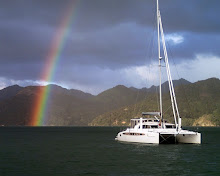 |
| Donning village attire |
|
 |
| Cave climb |
|
 |
| Anne with cave containing human remains |
|
 |
| Remains from days of warfare and cannabalism |
|
 |
| Village child |
|
 |
| Village from above |
|
 |
| Dinghy on beach |
|
 |
| Secluded beach walk |
|
 |
| Natural arch |
|
 |
| Happy hour dinghy raft-up in lagoon |
|
The remainder of our nearly two-week stay at remote Fulaga Island proved to be full of daily activities from dawn to dusk. The long, narrow reef pass proved to be a wonderful snorkeling and SCUBA diving spot with opportunities to see big fish, sharks and amazing coral formations. Timing the currents was important though as the tidal changes produced variations in water clarity and flow that would vary dramatically. When the current was flowing out and emptying the lagoon, underwater visibility suffered. During the peak of the incoming tide, clear ocean water brought better visibility and more big fish. It also provided a magic carpet-like flying experience. After taking our dinghies to the outside of the reef, we would drop in and be propelled like a group of flying super heros trough the pass while watching the amazing scenery go by beneath us. What fun! Smaller passes between Fulaga’s inner and outer lagoons also provided interesting places to play in the current and see some beautiful topography.
One day, we, long with other cruiser friends went ashore and walked to the village where we arranged for several young men and a woman to guide us through the dense jungle to the top of the island’s highest peak where we were treated to spectacular views of the area. Along the way, we explored several caves that had, for centuries, been used by the islanders for shelter from storms and hostile invaders. One cave even contained a pile of moss-covered, human skulls and bones dating back to the days of inter-tribal warfare and cannibalism. It made us glad that we were visiting these people in 2013 and not 150 years ago when we might have ended up as the main course for a village evening meal. In contrast to days past, when we returned to the village after our hike, our whole group was treated to a complimentary lunch of fish and fried rice served to us as while we sat on a woven mat in the shade of large tree. These friendly and humble people were incredibly generous and quick to share anything that they had.
During one of our expeditions by dinghy, we visited a sandy beach that stretched for miles. While exercising our legs, we scoured the beach for interesting shells. Anne’s efforts rewarded her with a beautiful Chambered Nautilus shell in nearly perfect condition. She was thrilled to add the rather rare, deep sea-dwelling specimen to her collection.
Our surroundings while anchored in the lagoon at Fulaga were idyllic but the weather was a little less so. Located on the windward edge of the island group, Fulaga sees no protection from winds from the south and east. While there, several days of strong winds and rain showers limited our outdoor activities. We did take advantage though of all of the best days to get out and explore. On one of the clear but windy afternoons, a group of us dinghied to the outside of the main reef pass to do a group SCUBA dive. The plan was to dive in two shifts with half the group wrangling dinghies while the others dived and then trade duties for the second shift. As the first group began gearing-up in their dinghies, while being buffeted by the strong winds and tossed about by the choppy seas, friends Ken and Beth drifted too close to a portion of the reef and were flipped over by a breaking wave. They were both thrown into the water, just feet from there engine’s rotating propeller, and all of their gear, including two expensive underwater cameras, was scattered in the surf zone over the jagged coral reef. Immediately realizing the seriousness of the situation, those of us nearby quickly leaped into action. Rankin from “Gypsea Heart” maneuvered his dinghy as close as he dared and swooped Beth from the churning white water. Mark, along with Derek from “Idyle Island” and Jon from “Evergreen” hurriedly swam though the breaking waves to Ken whose was doing his best to wrestle with the overturned dinghy that was being held in the worst possibly area by its anchor that had logged in the reef during the mishap. While being continually bounced off the jagged, coral bottom and pummeled by the incessant, breaking waves, the guys managed to right the dinghy and recover almost all of the lost gear. While they worked, the girls carefully maneuvered the other dinghies out of harms way assisting where they could. When the ordeal was finally over, the group had time to reflect on how dangerous the situation had been. For Ken and Beth, it could have had life threatening consequences. Needless to say, they were truly grateful for the assistance rendered. Ken would later comment, while hosting a “thank you” happy hour aboard their yacht, “Eagle’s Wings”, that the village-like community of cruisers is comprised of some of the most helpful, resourceful, and giving folks that he has ever known. We certainly agree his sentiments.
























